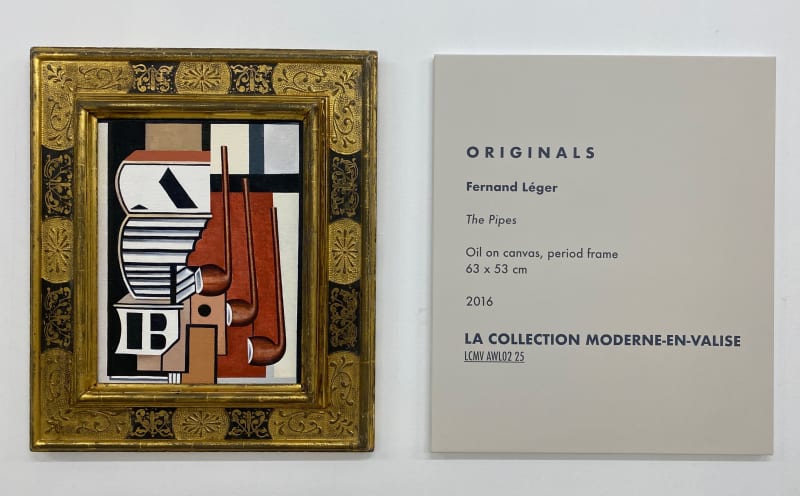Anthony Wilkinson is pleased to present Oslo based Dag Erik Elgin’s solo exhibition ‘La Collection Moderne-En-Valise’ - his first exhibition with the gallery and in London.
Infrastructure is what repeats … Its systemic properties tend to become visible only when the repetitions cease … When you turn on the faucet and water does not flow, the entire water system leaps into the cognitive field.
Reinhold Martin
Dag Erik Elgin’s Originals / La Collection Moderne-en-valise at Anthony addresses the architectures and other infrastructures that make it possible for a painting, as a material object, to travel and to appear.
The exhibition extends the artist’s long-term site surveys across projects including Sinthome (Albertinum, Dresden, 1996); Berlin North (Nationalgalerie im Hamburger Bahnhof, Berlin, 2004); Modernism Machine (Henie Onstad Kunstsenter, 2012); Museum Work (The National Gallery, Oslo, 2016); Originals (XVI Baltic International Triennial, Čiurlionis Museum, Kaunas, 2024); and, most recently, BOMBA (Kunstnernes Hus, Oslo, 2024).
In BOMBA, Elgin documented the former presence of Picasso’s Guernica at Kunstnernes Hus in 1938, the first stopover on the painting’s worldwide itinerary after its premiere at the 1937 World’s Fair in Paris. Alongside a stylized mural and archival material tracing the painting’s journey, Elgin left the two skylit halls largely empty, exhibiting the venue itself as the infrastructural condition for Guernica’s circulation and appearance. The exhibition space, its walls, light, and institutional infrastructure, were here recognized as the “pictorial support” of painting, in terms American formalists once reserved for the micro-infrastructure of canvas and stretcher. By focusing on Guernica as a pictorial fact tied to its infrastructural context rather than as a pictorial given, BOMBA echoed the work’s precarious theme: Nazi Germany’s doctrine of “total war,” directed against civilians and civil infrastructure.
In 1938, Kunstnernes Hus embodied the late-modernist exhibition venue par excellence: state-of-the-art infrastructure withgenerous skylit galleries and modern electric lighting. Housed in a listed early-Georgian townhouse (1719), Anthony Wilkinson’s extant domestic interior exhibits something else entirely: the frames structuring bourgeois life – dado rails, chimneypieces, plaster cornices, timber floorboards underfoot. Anthony Wilkinson departs fundamentally from the modernist museum’s aim to produce “optimal” viewing conditions, a program that, in effect, amounts to an active forgetting of the infrastructural conditions of visibility. The listed well-preserved townhouse instead recalls the horizon that domestic settings historically prescribed painting: the space between the dado rail and the ornamented ceiling.
One recalls that many of the galleries that first presented paintings by the historical avant-garde (the touchstone for much of Elgin’s work) were housed in domestic spaces. The field between dado rail and ceiling effectively set the parameters and dimensions of early modernist painting – at least until larger white-cube galleries, the notion of the museum as painting’s proper destination, enabled the Abstract Expressionists to scale up their canvases accordingly. With a Duchampian nod to this infrastructural history of painterly scale, Elgin’s criterion for the current show was that each work sit above the dado rail and fit within the largest checked bag airlines allow.
Works were selected from two series: Originals and La Collection Moderne. The polemically titled Originals are the artist’s own “reenactments” of modernist paintings: Cézanne, Picasso, Gris, Clausen, Klee. The works are best understood as free score-like reperformances of pictorial protocols, treated as suggestions laid down in wet paint a century ago, rather than attempts to relive or reconstruct the past, in Rankean terms, “as it really was.” Presented in historical frames, confirming the iconicity of the referential works, Originals nevertheless resist the classical notion of painting as a singular local event. Instead, focus is directed towards the milieubetween original and copy.
La Collection Moderne consists of painterly renditions of another type of pictorial framing: the museum label. The works trace a route from the discreet spot they are typically afforded in museums into the cognitive field proper – from parergon to ergon, from infrastructural supplement to an element that itself demands supplementation by a dado rail or (this) text.
In financial terms, the two series have distinct systems of circulation. While the text-paintings of La Collection Moderne are for sale and ostensibly “free” to circulate on the market as commodities, the Originals are not. They remain in the artist’s personal collection as raw material for future projects. By withholding these works from the market and reserving them for exhibition settings, Elgin retains some control over the conditions of their travel and appearance. An imperative that may be taken as a cipher for Elgin’s entire project: pulling the conditions of painting back into painting itself.

